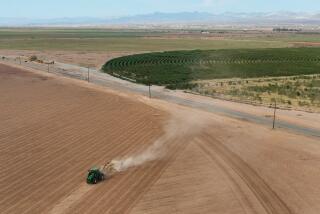Global Warming to Sap the West’s Water Needs, Study Finds
Global warming will have a devastating effect on the availability of water in the Western United States, according to a new study, which was billed as the rosiest of a series of climate forecasts despite its dismal outlook.
Even as a best-case scenario, it forecasts supplies falling far short of future demands for water by cities, farms and wildlife.
“You’d like there to be some good news in there somewhere, but unfortunately there is not,” said Tim Barnett, a research marine physicist at the Scripps Institution of Oceanography.
Overall precipitation levels are likely to remain constant, but warmer temperatures mean what would have fallen as snow will instead come down as rain.
Currently, the snowpack acts as a natural reservoir, storing water through the winter only to melt and release it during the spring and summer when demand spikes. If that precipitation falls as winter rain, however, it will fill rivers and streams at a time of year when demand is low.
The new study involved more than two dozen scientists and engineers, from institutions including Scripps, the University of Washington, the Energy Department and the U.S. Geological Survey, who undertook it as a test of a national climate forecasting effort. The results are expected to appear in an issue of the journal Climatic Change.
To create the forecasts, scientists began two years ago with current observations of the state of the world’s oceans -- those vast reservoirs of heat that drive climate -- and worked to translate that into real effects on precipitation and temperature in the Columbia, Sacramento and Colorado river basins. Although it is not the first study of its kind, it is the most rigorous, Barnett said.
Among the findings of what is forecast to occur in the next 25 to 50 years:
* Reservoir levels along the Colorado River will drop by more than a third and releases by 17%. The lower levels and flows will cut hydropower generation by as much as 40%.
* The Sacramento River will see reduced reliability in the volumes of water available for irrigation, cities and hydropower. With less fresh water, the Sacramento Delta will increase in salinity, disrupting the ecosystem.
* On the Columbia River system, there will be water in the summer and fall to generate electricity, or in the spring and summer for salmon runs -- but not both.
“The problem is you basically can’t resolve that trade-off,” said Dennis Lettenmaier, a professor of civil and environmental engineering at the University of Washington.
Other scenarios that gauge the effect of even moderate global-scale warming on the West suggest the effects could be two to three times worse -- or of the same magnitude but occurring sooner -- than the newer estimates, Barnett said.
The continued growth in the population of the West will exacerbate the problem. Indeed, that alone makes for a crisis, said Bill Patzert, a NASA research oceanographer who was not connected with the new research.
“The problem in the West is not climate change, it’s too many ... people using too much water,” Patzert said. “If nothing happens, we’re in trouble. If something happens, it’s worse.”
In California, the 2003 update to the state water plan will include for the first time consideration of the impact of climate change.
“Climate change just adds to the complexity [of] the already complex job of responding to changes in demand,” said Doug Osugi, an engineer in the water planning branch of the California Department of Water Resources.
One possible outcome is that the West would have to expand its network of dams, adding storage capacity to catch runoff, Barnett and others said.
“Generally, our infrastructure was designed with the current climate in mind, not a different one, so that creates problems,” said Pierre Stephens, lead water supply forecaster for the California Department of Water Resources.






